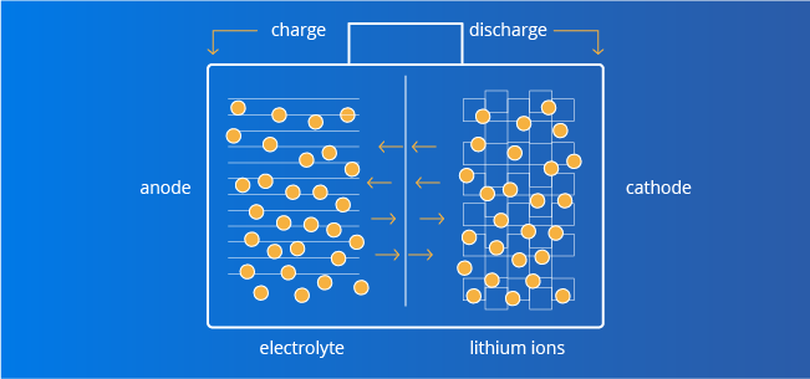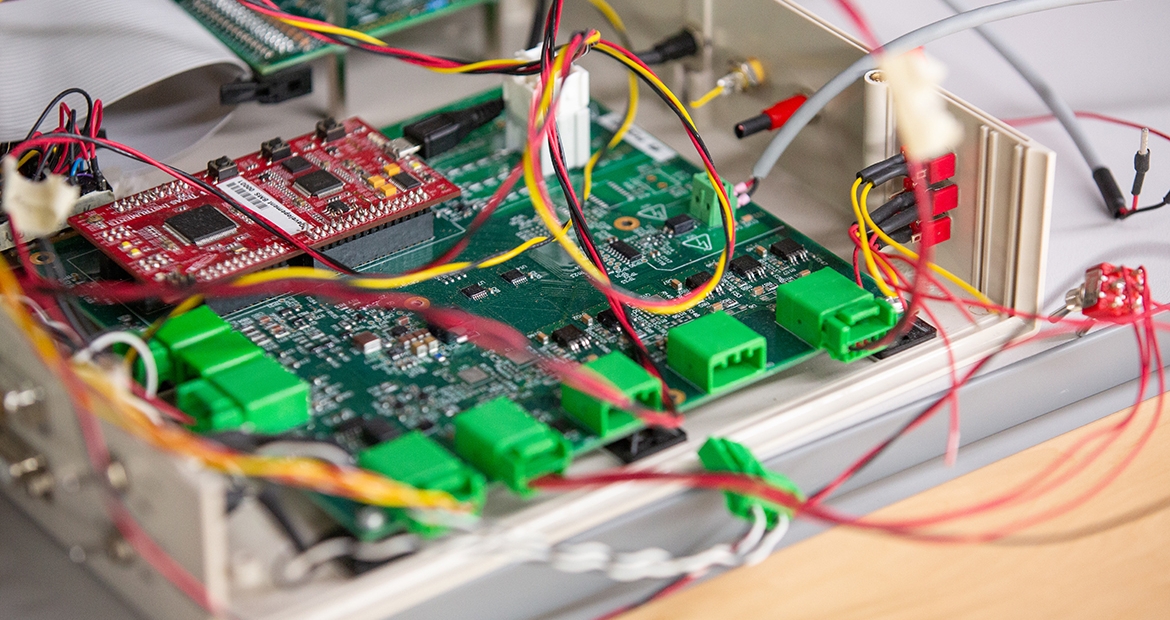При рассмотрении накопителей солнечной энергии, люди обычно сталкиваются с проблемой, какой тип аккумулятора следует выбрать. Сегодня наиболее распространенным выбором являются свинцово-кислотные аккумуляторы против литий-ионные аккумуляторы, и помочь вам решить, в этой статье мы сравним характеристики литиевой батареи и свинцово-кислотной батареи и ответим на некоторые часто задаваемые вопросы..

Обзор литиевой батареи и свинцово-кислотной батареи
литиевая батарея
Литий-ионные аккумуляторы изготовлены из металлического лития., в котором соединения лития используются в качестве электролитов между положительным и отрицательным электродами.. Обычно используется в портативных электронных устройствах., электромобили и системы хранения энергии.
Свинцовая кислотная батарея
Свинцово-кислотные аккумуляторы изготавливаются из свинца и представляют собой традиционный тип аккумуляторов, в которых электролитом между положительным и отрицательным электродами является серная кислота.. Они широко используются в автомобилестроении., Системы ИБП и применение солнечной энергии.
Как работают свинцово-кислотные батареи и литий-ионные батареи?
Как работают литий-ионные аккумуляторы
Литий-ионные аккумуляторы накапливают и выделяют энергию, перемещая ионы лития между положительными и отрицательными электродами.. Во время зарядки, ионы лития вытекают из положительного электрода (соединение лития) к отрицательному электроду (углеродный или кремниевый материал). Во время выписки, ионы лития перемещаются от отрицательного электрода обратно к положительному электроду.. Эта реакция достигается за счет ионной проводимости в электролите..

Как работают свинцово-кислотные аккумуляторы
Свинцово-кислотный аккумулятор — это аккумулятор, который накапливает и выделяет энергию в результате химической реакции между свинцом и диоксидом свинца.. В процессе зарядки, электрический ток проходит через батарею и окисляет свинец в свинцово-кислотном растворе до диоксида свинца. (позитивный) и чистый свинец (отрицательный). В процессе выписки, оксид свинца в растворе свинцовой кислоты реагирует с чистым свинцом, высвобождение электронов и генерация электрического тока. В свинцово-кислотных и литий-ионных батареях используется аналогичный процесс., но материал другой.
Разница между свинцово-кислотными аккумуляторами и литий-ионными аккумуляторами
Используемые материалы
Свинцово-кислотные и литий-ионные аккумуляторы работают практически одинаково., с той разницей, что материалы, используемые в качестве катодов, аноды, и электролиты. Свинцово-кислотные аккумуляторы используют свинец в качестве анода., оксид свинца в качестве катода, и серная кислота в качестве электролита. Литий-ионные аккумуляторы используют углерод в качестве анода., оксид лития в качестве катода, и соль лития в качестве электролита.
Продолжительность жизни
Срок службы батареи — это количество циклов зарядки и разрядки, которое может выполнить батарея без ущерба для ее производительности.. Срок службы литий-ионных аккумуляторов обычно составляет 5000 раз, и полная разрядка не влияет на срок службы. Свинцово-кислотные аккумуляторы могут прослужить долго 300 к 500 циклы, и полная разрядка повлияет на их жизненный цикл. Итак, за время жизни обоих, литий-ионные аккумуляторы более экономичны.
Расходы
Свинцово-кислотные батареи обычно имеют более низкую закупочную цену и стоимость установки по сравнению с литий-ионными батареями.. Но литий-ионные аккумуляторы служат дольше, чем свинцово-кислотные., поэтому свинцово-кислотные батареи более экономичны, чем литий-ионные, только при кратковременном использовании., и литий-ионные аккумуляторы, как правило, являются более выгодным выбором.
Емкость батареи
Емкость аккумулятора — это количество энергии, запасенной в аккумуляторе на единицу объема., и хотя показатели емкости различаются в зависимости от модели аккумулятора и производителя, Хорошо задокументировано, что технология литий-ионных аккумуляторов имеет значительно более высокую плотность энергии, чем свинцово-кислотные батареи..
Типичные литий-ионные аккумуляторы имеют емкость от нескольких сотен мАч до нескольких тысяч мАч., а типичные свинцово-кислотные батареи обычно имеют емкость от десятков ампер. (Ах) до сотен ампер (Ах). Как результат, литий-ионные батареи обычно имеют более высокую емкость и способны хранить больше энергии в батарее того же размера., что делает их более выгодными в приложениях, требующих высокой плотности энергии..
Глубина разряда (Министерство Обороны)
Глубина разряда батареи указывает процент батарей, которые могут безопасно расходовать энергию, не повреждая батарею., типичные литий-ионные аккумуляторы можно безопасно разряжать до 80 к 90 процент от их номинальной мощности, в то время как свинцово-кислотные аккумуляторы рекомендуется ограничивать разряд примерно до 50 процентов от их номинальной мощности для обеспечения оптимальной производительности и долговечности..
Как результат, литий-ионные аккумуляторы имеют более широкий диапазон глубины разряда, чем свинцово-кислотные аккумуляторы., а это значит, что вы сможете использовать литий-ионные аккумуляторы дольше и без подзарядки, а современные литий-ионные аккумуляторы, производимые сегодня, более эффективны, с Министерством обороны 100%.
Эффективность
Эффективность является ключевым моментом сравнения при сравнении литий-ионных и свинцово-кислотных батарей., с более эффективными батареями, заряжающимися быстрее, и аналогична глубине разряда, увеличение эффективности означает, что эффективная емкость аккумулятора выше.
Большинство литий-ионных аккумуляторов имеют КПД 95% или выше, из-за высокого внутреннего сопротивления, Свинцово-кислотные аккумуляторы выделяют определенное количество тепла и теряют энергию во время зарядки и разрядки., а эффективность свинцово-кислотных аккумуляторов составляет около 80-85%.
Плотность энергии
Плотность энергии = (номинальное напряжение батареи (В) x номинальная емкость аккумулятора (Ах)) ÷ вес батареи
Литий-ионные батареи обычно имеют более высокую плотность энергии и, следовательно, способны хранить больше энергии при том же объеме или весе..
Свинцово-кислотные аккумуляторы обычно имеют меньшую плотность энергии., поэтому они хранят меньше энергии при том же объеме или весе и могут потребовать больше места и веса для достижения той же выходной мощности..
Долговечность
Срок службы аккумулятора зависит от того, как долго он может работать.. Свинцово-кислотные аккумуляторы могут работать до 2 лет при правильном уходе, то есть, взимается плата после 50% использовать, и только 350 циклов или один год, если он полностью опорожнен или более 80%. Свинцово-кислотные аккумуляторы имеют более высокую скорость саморазряда., поэтому они могут потерять заряд при длительном хранении, и их необходимо периодически подзаряжать для поддержания их работоспособности..
На литий-ионные аккумуляторы предоставляется гарантия 10 годы и последний 10,000 циклы. Литий-ионные аккумуляторы обычно имеют меньшую скорость саморазряда., поэтому при длительном хранении, они могут оставаться заряженными в течение более длительного периода времени без необходимости частой подзарядки.
Время зарядки
Литий-ионные аккумуляторы заряжаются в восемь раз быстрее, чем свинцово-кислотные.. При тех же условиях мощности, если свинцово-кислотный аккумулятор потребляет более 10 часы для зарядки, тогда литий-ионный аккумулятор можно будет зарядить менее чем за три часа.
Безопасность
Будь то свинцово-кислотный аккумулятор или литий-ионный аккумулятор., перезарядка может привести к взрыву. Серная кислота в свинцово-кислотных аккумуляторах очень агрессивна и может привести к утечке., который может производить водород и кислород при перезарядке, приводящий к взрыву. В литий-ионных батареях, вероятность термического разгона высока. Термический разгон — это состояние, которое возникает, когда тепло, выделяемое внутри батареи, превышает количество тепла, излучаемого в окружающую среду., потенциально может вызвать взрыв батареи.
Поэтому, будь то литий-ионный аккумулятор или свинцово-кислотный аккумулятор, это требует правильного обращения, монтаж и техническое обслуживание для обеспечения безопасной эксплуатации.
При выборе между литий-ионными и свинцово-кислотными аккумуляторами, следует учитывать конкретные требования безопасности и стратегии снижения рисков для удовлетворения потребностей предполагаемого сценария применения..

Приложение
Применение литий-ионных аккумуляторов
- Мобильные устройства: Литиевые аккумуляторы широко используются на рынке мобильных устройств., например, смартфоны, таблетки, ноутбуки и портативные аудиоустройства, потому что они легкие, эффективны и имеют высокую плотность энергии.
- Электрические транспортные средства: Транспортные средства, такие как электромобили, электрические велосипеды и электрические скутеры используют литиевые батареи в качестве основного источника энергии из-за их высокой плотности энергии., долгий срок службы и быстрая зарядка.
- Бытовая электроника: Бытовая электроника, такие как дроны, умные домашние устройства, и портативные источники питания, также широко внедрили технологию литиевых батарей, поскольку они могут обеспечить длительный срок службы и стабильную работу..
Применение свинцово-кислотных аккумуляторов
- Автомобили и мотоциклы: Традиционные автомобили и мотоциклы с двигателями внутреннего сгорания часто используют свинцово-кислотные аккумуляторы в качестве пусковых из-за их более низкой стоимости и надежности..
- UPS (Бесперебойный источник питания) : Свинцово-кислотные аккумуляторы широко используются в системах ИБП для обеспечения временного резервного питания и обеспечения продолжения работы оборудования в случае отключения электроэнергии или сбоя в сети..
- Системы хранения солнечной энергии: В некоторых недорогих и небольших солнечных системах, свинцово-кислотные аккумуляторы также используются для хранения солнечной энергии для последующего использования..
Суммируя, литиевые батареи имеют широкий спектр применения в мобильных устройствах., электромобили и бытовая электроника и другие области, благодаря высокой плотности энергии и длительному сроку службы, подходит для сценариев с высокими требованиями к производительности и объемному весу.
В отличие, Свинцово-кислотные аккумуляторы в основном используются в традиционных стартерных аккумуляторах автомобилей., Системы ИБП и некоторые небольшие системы хранения солнечной энергии., подходит для экономичных приложений и сценариев с низкими требованиями к плотности энергии.
Заключение
Как и при любой крупной покупке., такие как солнечные батареи и батареи (в паре или в одиночку), вам нужно рассмотреть свои варианты. Ты можешь связаться с GYCX Solar чтобы получить ценовое предложение на вашу солнечную установку «под ключ» от предварительно проверенного местного установщика солнечной энергии. Если вы заинтересованы в сопряжении аккумуляторной батареи с вашей системой, Вы можете нажать здесь, чтобы получить ценовое предложение сейчас. Даже если установщики солнечных батарей сами не устанавливают батареи, они могут спроектировать системы солнечных батарей, чтобы вы могли позже добавить батареи.
